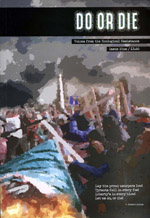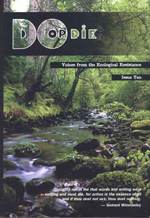The Archives
-
Do or Die, Most Popular, Periodicals
Do or Die – The Complete Set!
04.09.14 | PermalinkDo Or Die #1-10 (1993-2003, Brighton, England.)
A few years ago a friend asked me if I had a complete set of Do or Die, the British Earth First! publication that inspired and incited eco-warriors throughout the 1990s and early 2000s. At one time I did have them, but they had long since been stolen by a Joint Terrorism Task Force.
After a brief discussion, we decided that Do or Die was too important to fade into obscurity. We began tracking down each issue, and decided that while we were at it we ought to archive some other publications as well. That effort is how this web site began, and now, thanks to 56a infoshop of South London and Tim @ NEDS Northampton, we can finally share the very rare issue #2. This completes our collection, and our original mission as well.
When read as a set, Do or Die is a chronicle of people from across the globe counter-striking capitalism, ecocide, and the state. Each issue is better than the last, but more importantly, each page is a spark licking at the fuse of the bomb that is your heart. Once lit, you’ll know that these pages are not mere history, but a reminder that we can explode onto the world stage like the fighters before us have. Do or die, now is the time to rise.
…
-
Periodicals
Lomakatsi
09.07.12 | PermalinkLomakatsi #1, 2, 3, and 4 (1987-1989, Washington, DC)
Many of the participants in the first boom of U.S. animal liberation activity were radicals, and not just when it came to their critique of non-human slavery. As I have mentioned in previous posts, speciesism is so intrinsic to most cultures that people embracing a pro-animal ethic almost always came from the fringes. These early pioneers pushed the message, took direct action, and put the plight of animals front and center in works of art, music, and literature. What became of these rebels when the movement became more mainstream, and thus more profitable to the careerists at national organizations? As a generation of gray, corporate pseudo-activists began to wield suits and ties instead of spanners and bolt cutters the old guard revolted in a variety of ways- one of which was an eclectic, anarchist journal known as Lomakatsi.
Taking the Hopi word for “Life in Balance,” a small collective of artists and activists set out to reject the dominant themes running through other, tamer publications. More than that, they started a project to live communally on a small parcel of land and experiment with more sustainable, less technological ways of living. By sharing their space with each other, and their thoughts with the world, the rebels continued to have an impact on the direction of the mvoement.
During it’s short life, Lomakatsi circulated about 1,000 copies per issue, introduced anti-civilization themes to AR folks through articles by John Zerzan, (And a letter from Feral Faun in one issue!) and stirred up plenty of controversy. Each issue contained DIY instructions for sabotage, oddball illustrations and comics, and advocacy for some ideas that were challenging to say the least. Their intentional community eventually stopped producing a journal, but those following animal liberation history will certainly see the influence that Lomakatsi had on our movement’s dialogue as we moved into the 1990s.
…
-
Do or Die, Periodicals
Do or Die #5
07.02.11 | PermalinkDo Or Die #5 (1995, Brighton, England)
The story of Earth First! in the United States is well documented and frequently repeated, and someday it will certainly make it’s way to digital distribution here on Conflict Gypsy. (Scanning those hundreds of copies of EF! Journal is going to put our volunteers into early graves if we are not careful, so don’t expect to see a full set anytime soon!) Until that time it is our pleasure to delve into the history of Earth First! elsewhere in the world, starting in England and the other places still under colonial rule known as the “United Kingdom.”
Beginning in 1991 there was an explosion in activism across the pond. Wilderness, urban environmental, anti-road, alternative transportation, animal liberation, anarchist, squatters rights, and other specialized, single issue activist realms began to coalesce into an exciting new mass. The origins of this widespread movement had broad roots. Some trace its beginnings to the poll tax riots, others say it was government crack downs on raves, squats, and social centers. Where ever it came from, it grew within a few short years into a spectacular and inspiring mess for the status quo!
From encampments protecting wild areas, to sabotage, to street protests that took over whole city centers, the UK suddenly seemed alive with resistance. While never reaching a size that threatened the powers that be, these outbursts of love and aggression were never the less refreshing to those of us in the United States longing for a similar explosion in revolutionary zeal. Suddenly, Do Or Die became the must read publication that no-one could quite seem to get their hands on!
Professionally bound and book sized, each issue of DoD contained news, research and analysis about the exploits of radical activists worldwide. Conflict Gypsy will be posting a full set of these journal format prizes as they become available to us. The earliest issue in our collection, #5, contains lengthy articles on the live export protests that eventually ended with the death of Jill Phipps, the NO M65 campaign, and virtually everything else worth noticing in Europe in 1995. If you have earlier editions of DoD, please contact us at conflictgypsy (at) gmail (dot) com

…

















